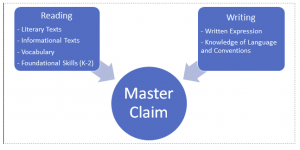Overview
CenterPoint’s EL Curriculum-Aligned Interim Assessments have been thoroughly reviewed by EL Education® and align with standards and topics covered in the curriculum — a curriculum that has received the highest ratings by EdReports.
The assessments are designed to help educators understand the breadth of students’ skills in comprehending rich, complex texts, including the types of texts that typically appear in summative assessments. Students read and respond to authentic, complex literary and informational texts and engage in performance-based tasks. These standards-based assessments can be used as part of a comprehensive assessment system to measure student progress and inform instruction.
Evidence-Centered Design
CenterPoint’s EL Curriculum-Aligned Interim Assessments provide educators with the information needed to monitor student performances in English Language Arts so that students who may need additional intervention or enrichment opportunities can be easily identified. Using evidence-centered design helps to ensure the interims provide quality data that can be used to make informed decisions.
The design of these interim assessments begins with the inferences or claims we want to make about what we want students to know. To support the claims, we must gather evidence from tasks that are designed to elicit specific evidence in support of the claims.
Assessment Claims
The EL Curriculum-Aligned Interim Assessments were designed to provide information about a master claim and two major claims. The claims are shown in the diagram and defined below.

Master Claim
On track or ready for college and careers.
Reading
Students read and comprehend complex literary and informational texts.
Writing
Students write effective arguments, informational compositions, and narratives when using and/or analyzing sources.
An additional subclaim is assessed in conjunction with writing — Language:
Language
Students know and use standard English conventions when writing.
Assessing Reading and Writing
College- and career-ready standards in English Language Arts and Literacy are designed to describe the knowledge, skills, and understandings essential to postsecondary success. This includes an emphasis on close, analytic reading, comprehension of a range of grade-level complex texts, and writing effectively when using and/or analyzing sources. In addition, students in grades K-2 have an opportunity to demonstrate knowledge and progress toward mastery of foundational skills.
The EL Curriculum-Aligned Interim Assessments are designed to measure student accuracy of comprehension and the ability to find and cite evidence from the text as well as student written expression and knowledge of language and conventions. The reading comprehension items are aligned to college- and career-ready standards in Reading, while the constructed-response items are aligned to college- and career-ready standards in Writing and Language.
Evidence and Tasks
Each question or task on the interim assessments was designed so that students could demonstrate evidence of learning to support the claims. Additionally, CenterPoint utilizes item types that provide the best way for students to show the evidence of learning that is desired. Below is a list of some of the item types utilized on the interims.
Machine-Scorable Item Types
- Selected Response – Multiple Choice (MC)
- Selected Response – Multiple Selection (MS)
- Evidence Based Selected Response (EBSR)
- Technology-Enhanced Item (TEI):
- Gap Match
- Cloze Association
- Drag and Drop
- Cloze Drop Down
- Text Highlight/Hot Text
- Choice Matrix
- Human Scored Item Type
- Constructed Response
Universal Design
In addition to designing assessments within the framework of evidence-centered design, CenterPoint applies principles of universal design to increase the accessibility, and therefore fairness, of each assessment for all students. Universal design is essential to valid measurement practices. If assessment questions are not accessible or fair for every student, then the evidence collected will not provide meaningful information about students’ knowledge and/or abilities.
Assessment Specifications
College- and career-ready standards in English Language Arts are designed to describe the knowledge, skills, and understandings essential to postsecondary success. This includes an emphasis on reading comprehension and writing skills.
Number of Questions and Versions
Grades K-2
There are four forms, each with three parts:
- Part 1: Reading Foundational Skills — 5 machine-scorable items
- Part 2: Reading and Listening — 8-12 scorable items
- Part 3: Writing and Speaking — 1 constructed response writing item
The K-2 assessments were designed in parts so that districts, schools, and educators have flexibility in administering each form: each part can be administered independently or in the same time period depending on preference and need. Please refer to the K-2 EL Curriculum-Aligned Interim Assessment Blueprints to view the standards assessed within each interim form.
Grades 3-8
There are three versions to choose from for each of the three forms:
- Version 1: 16 machine scorable items that measure reading standards
- Version 2: 16 machine scoreable items plus one constructed response writing item (educator-scored)
- Version 3: 16 machine scoreable items plus an alternate constructed-response writing item (educator scored)
The 3-8 assessments were designed to allow the flexibility of assessing Reading OR assessing both Reading and Writing. Districts select the version of the form most appropriate for their district implementation.